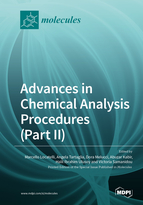Advances in Chemical Analysis Procedures (Part II): Statistical and Chemometric Approaches
A special issue of Molecules (ISSN 1420-3049). This special issue belongs to the section "Analytical Chemistry".
Deadline for manuscript submissions: closed (31 December 2019) | Viewed by 51129
Special Issue Editors
Interests: innovative (micro)extraction procedures; hyphenated instrument configurations; bioactive compounds; characterization; fingerprints; method validation; HPLC; mass spectrometry; biological matrices; chromatography; analytical chemistry; sample preparation; green analytical methodologies
Special Issues, Collections and Topics in MDPI journals
Interests: method development; analytical and bioanalytical chemistry; method validation; hyphenated assay; HPLC
Special Issues, Collections and Topics in MDPI journals
Interests: chemometrics; environmental chemistry; forensics; food chemistry; pharmaceutics
Special Issues, Collections and Topics in MDPI journals
Interests: chromatographic stationary phases; substrate-free solid-phase extraction sorbents; molecular imprinting technology; sorbents for environmental pollution remediation; miniaturized sample preparation devices; field deployable sample preparation technology
Special Issues, Collections and Topics in MDPI journals
Interests: analytical method development; chromatography; pre-concentration and seperation methods; trace analysis; molecular and atomic spectroscopy
Special Issues, Collections and Topics in MDPI journals
Interests: analytical chemistry; sample preparation; chromatography; HPLC; method validation; method development; separation science; food analysis; bioanalysis; environmental analysis; green analytical chemistry; sorptive extraction; microextraction techniques
Special Issues, Collections and Topics in MDPI journals
Special Issue Information
Dear Colleagues,
Analytical chemistry deals with both qualitative and quantitative measurements, although modern approaches are more inclined towards quantitative science. In analytical laboratories, the measurements are usually made on a small group of representative samples to determine the presence and the concentration of the target analytes. Following the data collection, the results are tabulated to evaluate the quality of the data. An important area in evaluating analytical data is represented by statistical approaches, which should not be considered only for evaluating the results of experiments, but also in the planning and design of experiments. The design and optimization process should include the identification of those experimental factors and then combine them in an optimal way, to obtain the best sensitivity, selectivity, etc. The major quantitative chemical problems can also be performed with chemometric measurements. The starting point of multivariate measurements is usually represented by principal component analysis (PCA) which can reduce the dimensionality of the data, eliminate false information, search outliers, etc. The modern tools for the various measurements are completely devoid of manual controls and are controlled by personal computers that record and manage the obtained data. In recent years, appreciable progress has been made and in the most modern analytical chemistry laboratories, instruments not only allow quick and precise data calculations but also include instrument performance control and reporting of any malfunctions.
Subtopics: Chemometric approaches; analytical statistical approaches; data elaboration
Schedule: Manuscript Submission Deadline: August 2019
Peer Review Due: September 2019
Revision Due: October 2019
Notification of Acceptance by the Guest Editors: October 2019
Final Manuscripts Due: November 2019
Prof. Dr. Marcello Locatelli
Dr. Angela Tartaglia
Dr. Dora Melucci
Dr. Abuzar Kabir
Prof. Dr. Halil Ibrahim Ulusoy
Prof. Dr. Victoria Samanidou
Guest Editors
Manuscript Submission Information
Manuscripts should be submitted online at www.mdpi.com by registering and logging in to this website. Once you are registered, click here to go to the submission form. Manuscripts can be submitted until the deadline. All submissions that pass pre-check are peer-reviewed. Accepted papers will be published continuously in the journal (as soon as accepted) and will be listed together on the special issue website. Research articles, review articles as well as short communications are invited. For planned papers, a title and short abstract (about 100 words) can be sent to the Editorial Office for announcement on this website.
Submitted manuscripts should not have been published previously, nor be under consideration for publication elsewhere (except conference proceedings papers). All manuscripts are thoroughly refereed through a single-blind peer-review process. A guide for authors and other relevant information for submission of manuscripts is available on the Instructions for Authors page. Molecules is an international peer-reviewed open access semimonthly journal published by MDPI.
Please visit the Instructions for Authors page before submitting a manuscript. The Article Processing Charge (APC) for publication in this open access journal is 2700 CHF (Swiss Francs). Submitted papers should be well formatted and use good English. Authors may use MDPI's English editing service prior to publication or during author revisions.
Keywords
- statistics and chemometric approaches
- quantitative analysis
- data elaboration
- multivariate models
- PCA











